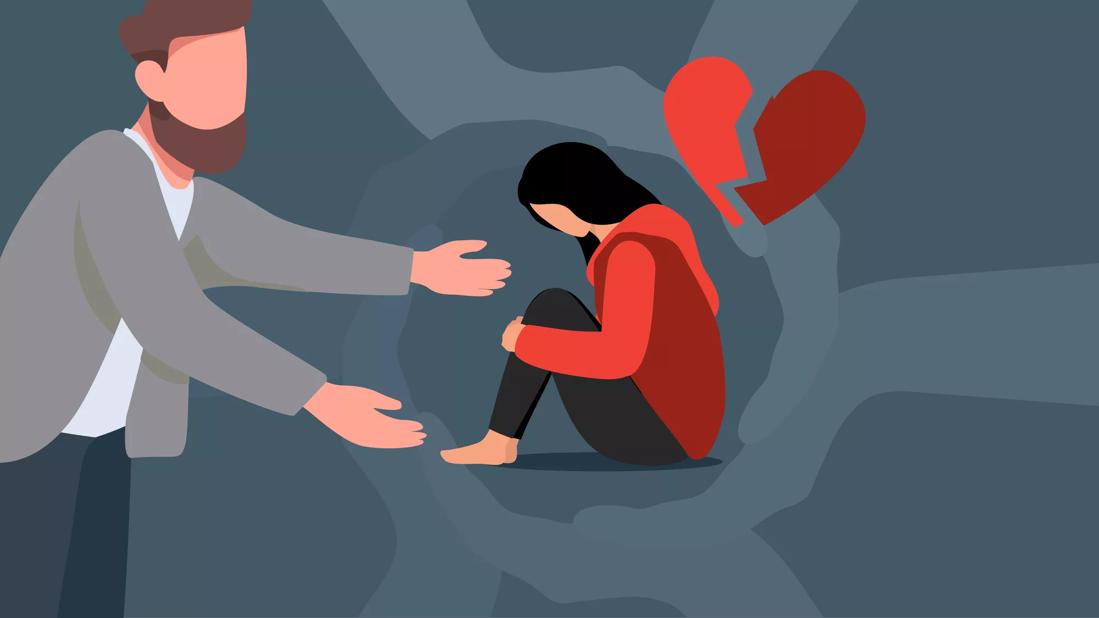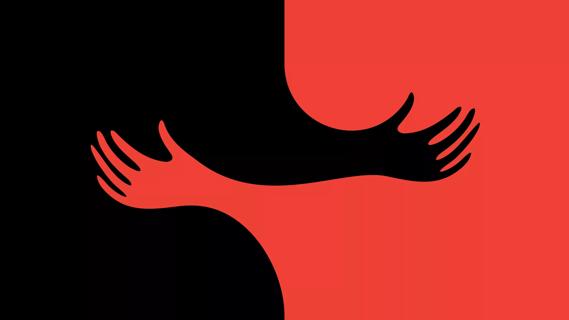Advertisement
The cycle of abuse is a simple theory for understanding relationship violence — but the model might not fit everyone’s situation

According to the U.S. Centers for Disease Control and Prevention (CDC), 1 in 3 people who identify as female and 1 in four who identify as male have experienced violence at the hands of an intimate partner in the United States. That’s just physical abuse. There are lots of other kinds of abusive behavior that can have similarly devastating effects. And those numbers only represent the U.S. The number of people who are experiencing or healing from abuse around the world is staggering.
Advertisement
Cleveland Clinic is a non-profit academic medical center. Advertising on our site helps support our mission. We do not endorse non-Cleveland Clinic products or services. Policy
It’s natural to want to understand why and how relationships can become so toxic. Many theories out there try to explain it. But among the best known is the “cycle of abuse” theory. It’s been around for over four decades now ... but what exactly is it? And does it really help us understand (and end) abusive relationships?
We asked psychologist Kia-Rai Prewitt, PhD, to break it down. She explains the cycle of abuse’s four stages, the issues with the model and what to do if you’re experiencing abuse of any kind.
The cycle of abuse isn’t a concrete thing. It’s an idea. Nearly half a century ago, psychologist Lenore Walker, PhD, wrote about it in her award-winning 1979 book, The Battered Woman.
(And yes, for those of you wondering, that book also gave us the concept of “battered woman syndrome.” But that’s a story for another time.)
Dr. Walker interviewed 1,500 women who experienced domestic violence — physical abuse, to be specific — at the hands of their (male) intimate partners. As she reviewed their stories, she noticed patterns of behavior emerging.
The cycle of abuse theory was the result: It’s Dr. Walker’s way of explaining an abuser’s behavior in a relationship.
“It helps us understand how people can be groomed for abuse,” Dr. Prewitt says, which makes it easier to understand how an abusive relationship starts in the first place. The cycle of abuse also helps explain trauma bonding.
As is true of most psychological research, some elements of the cycle of abuse theory have aged better than others. It’s still regularly critiqued, modified and discussed in academic circles, but the phrase “cycle of abuse” has also become bigger than the theory. It’s now a popular term used to describe all sorts of troubled relationships.
Some people benefit from having this framework to analyze their relationships. Others find it hurts. Still others use an imperfect fit with the model to brush off concerns — which can be downright dangerous.
The original cycle of abuse model has four key stages:
It’s actually more like a spiral than a circle. When she first created the model, Dr. Walker explained that — over the course of a relationship — the stages would get shorter and the violence more intense. In other words, the experience of the relationship is like being on a treadmill that’s being turned up. The abuse escalates over time.
For the sake of illustration, we’re going to review the cycle as if it’s happening for the first time, at the start of a relationship.
Advertisement
“It’s not like somebody shows up with a sign on their heads that says, ‘I'm going to abuse you in six months,’” Dr. Prewitt notes. “When you start dating somebody, they show you the best things about them — there’s a honeymoon phase.”
It’s only later that the abusive behavior becomes obvious. The first glimmers of trouble are what Dr. Walker described as “tension-building.”
When the tension-building stage begins, the relationship is still in the honeymoon phase.
“Maybe you see little signs, some red flags here and there that your partner is easily angered, or that their assessment of certain situations may be a little extreme,” Dr. Prewitt explains. “But it’s not necessarily directed toward you — it’s sometimes directed at others.”
As the relationship gets more comfortable and secure, those moments happen more and more often.
Slowly but surely, Dr. Prewitt says that your partner will get more aggressive with you. Maybe they snap at you more often. Maybe they make a few sexually inappropriate comments that catch you off guard. Maybe they start criticizing little things, getting jealous or engaging in self-destructive behaviors.
Whatever they’re doing, it’s not what you signed up for. But when the relationship is good, it’s so good. So, you overlook the occasional record scratch, the subtle but forgettable red flags.
And then it happens. Your intimate partner does something undeniably abusive.
There are many different kinds of abuse. And some are more immediately obvious than others. We all know that an act of physical violence counts as abuse, but tearing up a passport is abusive, too. Forcing somebody to go beyond their sexual comfort zone is abusive. Threatening self-harm to keep you from doing something they don’t want you to do is abusive. Stealing a partner’s credit card or controlling their finances is abusive. Installing a tracking app on your cell phone without your knowledge or consent is abusive. Mocking you in front of your friends? That’s also abusive.
If you’re not sure whether a behavior crosses the line into abuse, ask yourself these two questions:
If the answer to either of those questions is yes, Dr. Prewitt says that it’s abuse.
Whether you recognize the behavior as abusive in the moment or not, you’ll respond to it. And there’s no one way to do that. Calling the police or kicking a partner out are responses. But so is having an argument, walking away or crying. What matters is that by responding, you’re attempting to re-establish the respect and boundaries you had before.
According to the cycle of violence model, that means it’s time for the abuser to start apologizing and trying to “fix” the situation.
As with every other stage of the cycle, reconciliation means different things in different relationships. In some situations, it’s a simple apology. In others, it looks like hoovering or full-on love bombing. The goal is to relieve the tension and return to the honeymoon phase of the relationship.
Advertisement
Dr. Prewitt is clear: The person behaving abusively may be genuinely ashamed and regretful, but using control to keep someone in a relationship is never OK. After all, if everybody who behaved abusively were a mustache-twirling villain, they’d be easy to avoid.
No, the apologies, promises and romantic gestures could very well be coming from a truthful place. But — at least, in the cycle of abuse model — it’s typically an attempt to regain control over the person being abused (and setting the stage for future trespasses).
The word “calm” suggests that nothing’s really happening in this fourth stage of the cycle of abuse. But in fact, a lot is happening.
This is when the abusive partner starts slowly transitioning from apologizing for their behavior to:
Basically, it’s all about gaslighting the individual they abused — convincing them they deserved what happened to them, that they’re misremembering the event, that their behavior was equally abusive or that any residual hurt they have over the incident is invalid.
The calm stage is crucial to the cycle of abuse. It sows the seeds of confusion, self-doubt and apprehension that allow the cycle to perpetuate itself.
Over time, the tension will begin to build again, restarting the cycle. And every time it repeats, it’s a little faster, a little more extreme and that much harder to end.
It’s not unusual to hear people talk about abuse as cyclical. It’s a simple and familiar way to understand a traumatic experience. That simplicity can be powerful — but it also has limitations. And in the case of abuse, those limitations can have negative consequences for the people the model was created to help.
Here are a few reasons why the cycle of abuse might not be the best way to think about abusive behavior patterns.
Dr. Walker created the cycle of abuse theory by interviewing survivors of intimate partner violence and analyzing their stories. But as later critiques — and Dr. Walker herself — noted, she only interviewed white, cisgender, heterosexual women living in Colorado. The participants also weren’t randomly selected. They volunteered. Later studies show the stages laid out in the model don’t always apply to people with different backgrounds and life experiences. And even within the not-so-diverse original sample, there was plenty of variation. For example, only 58% of the women Dr. Walker interviewed said they went through a reconciliation stage.
A lot has happened since 1979. We now understand that there are lots of different kinds of abuse beyond physical and sexual. Now, we also recognize that a person can experience emotional abuse, verbal abuse, financial abuse, technological abuse, cultural and spiritual abuse, reproductive coercion and abuse of immigration status, for example. These behaviors don’t map cleanly onto a model designed to explain physical abuse. The cycle of violence theory also isn’t great for understanding mutually abusive relationships. And it doesn’t account for the most dangerous times in an abusive relationship, like when the partner experiencing violence is pregnant or when the person being abused is attempting to leave the relationship.
The cycle of violence does a good job accounting for certain kinds of changes in abusive relationships, but not others. It allows for escalation, meaning the cycle getting faster and more violent. Other changes, not so much. That’s a problem because abusive relationships often evolve (or devolve). For example, an abuser may stop trying to reconcile with their partner. It’s also common for the tension period (or sadly, the abuse itself) to become a constant feature of the relationship.
Advertisement
While we talk about it differently now, the cycle of violence model originally made two big assumptions:
Dr. Prewitt reinforces that anybody can end up in an abusive situation, and it’s NEVER their fault. Childhood trauma may play a role in a person’s experience of victimization, but it might not. There are also plenty of reasons a person might stay in, or struggle to end, the cycle of abuse.
“Anytime we end a relationship, that’s a significant loss. There’s always an emotional component to it, but there are also a lot of different things that you might lose when you leave a relationship, depending on your personal circumstances,” Dr. Prewitt says.
Some people worry about losing custody of their children. Some risk losing their friends, family or faith community. From housing and financial support to citizenship, the consequences of walking away from an abusive relationship can be huge. And let’s not forget that in order to leave, some people have to risk their physical safety.
The stakes sometimes feel impossibly high, but — contrary to the original theory — it is possible to end a cycle of abuse. It can be hard to do, for sure: According to the National Domestic Violence Hotline, it takes an average of seven attempts to leave an abusive relationship. But it can be done. And there are a lot of people who are ready, willing and able to help you do it when you’re ready. More on that in a bit.
Leaving an abusive relationship is no small thing. It can have dangerous — even deadly — consequences. Based on the cycle of abuse framework, it’d be easy to (incorrectly) assume that the “calm” stage is the safest stage to make a break for it. But that’s not really how abusive relationships work. If you’re trying to get out of a dangerous situation, Dr. Prewitt says you should always take as many safety precautions as possible, regardless of how your abuser is behaving in the moment. Nobody — including the person doing harm — is bound by the cycle.
If the concept of the cycle of abuse doesn’t resonate for you, rest assured. Dr. Prewitt says there are many other theories that may help you understand intimate partner violence. Here are three newer models, just to give you a sense of what’s out there:
For many people, learning about abuse as a broader social phenomenon is an important part of the healing process. But sometimes, trying to fit personal experiences into a theory hurts more than it helps. If that’s the case for you, don’t do it. Protect whatever peace you have, in whatever way is healthiest.
We’ve talked through the cycle of abuse and its issues. Now, it’s time to get practical. Cycles are perpetual, but this one doesn’t have to be. You can end the cycle of abuse.
It’s only a three-step process, but those three steps can seem big and overwhelming. Let’s break them down.
When you’re in the thick of a relationship, it can be hard to recognize harmful patterns of behavior. And it can be even harder to accept that somebody you love is abusive. Using an abstract model like the cycle of abuse may or may not be helpful in that process.
Advertisement
Your own behavior — or the way you change your behavior in response to your partner — can also offer important clues, according to Dr. Prewitt.
“For example, if you notice that you’re withdrawing from people, or cutting yourself off from loved ones whether self-initiated or initiated by your partner, that’s a sign something is wrong,” she says. Other signs include declining physical and mental health, increasing substance abuse, difficulty concentrating, appetite changes and sleep issues.
Once you know the score, it’s time to start making moves to change it. But it’s important to do it with care and caution.
If you have access to a phone or the internet, use it to call, text or visit the National Domestic Violence Hotline website. They have a lot of tools to help you, including a whole section of their website dedicated to making a safety plan. It covers things you might not have even thought of, like pet safety, code phrases for getting help in an emergency and legal documents you’ll want to take with you if you can.
If you don't live in the US, you can use the NO MORE Global Directory to get connected with hotlines and resources in your area.
NOTE: Internet safety is very important when you’re trying to end an abusive relationship. If you haven’t taken precautions already, be sure to delete any websites you wouldn’t want your partner to know you accessed from your browser history, including this one. Take similar care with printed materials.
“You can make the decision to leave by yourself — and some people may be capable of breaking away from an abusive relationship on their own — but I still recommend getting some type of support,” Dr. Prewitt urges.
If you’re not able to connect with people you know, use the National Domestic Violence Hotline’s local resources page to get connected with people and resources in your area. They can direct you to counselors, shelters, legal aid services, food assistance, interpreters, childcare support and more.
“A lot of people don’t leave because they don’t know what the other side looks like,” Dr. Prewitt recognizes. “Having somebody there to support you along the way, so you’re not doing this by yourself, really matters.”
The cycle of abuse isn’t a perfect model, but it gets one thing right for sure. Something Dr. Prewitt tells many people: “As long as you stay in a bad relationship, you’ll continue to feel unsure of yourself and your partner. Walking on eggshells every day, trying to anticipate your significant other’s next move is unhealthy. The harm will continue.”
It’s something you may need to hear a lot as you consider your next steps.
Here’s another thing Dr. Prewitt might tell you if she saw you in her clinic: “Leaving will be uncomfortable, but it doesn’t mean you’re making the wrong decision. Change is often uncomfortable, but you can do this. You are not alone. Seek help if you are unsure where to turn.”
Learn more about our editorial process.
Advertisement

Sleeping with separate blankets can help you get the ZZZs you need — without fighting for covers all night

Look to activities you enjoy — or try a new hobby — to help foster meeting new people

This romantic orientation involves little to no romantic attraction to others and exists on a spectrum

The key to letting go of resentment is unpacking complex emotions and learning how to express them

Sexting has become all too common among kids, putting them at risk for bullying, blackmailing and human trafficking

Keeping open lines of communication and working together as a team for your children are key to co-parenting

Don’t let the romantic terminology fool you: Karmic relationships are dysfunctional by definition

It’s not about embracing your dark side — it’s about showing up for yourself

Focus on your body’s metabolic set point by eating healthy foods, making exercise a part of your routine and reducing stress

PFAS chemicals may make life easier — but they aren’t always so easy on the human body

While there’s little risk in trying this hair care treatment, there isn’t much science to back up the claims